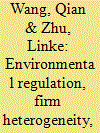| Srl | Item |
| 1 |
ID:
171416


|
|
|
|
|
| Summary/Abstract |
We revisit command-and-control regulations and compare their efficiency, particularly an emission cap regulation that restricts total emissions and an emission intensity regulation that restricts emissions per unit of output under emission equivalence. We find that in both the most stringent target case, in which the target emissions level is close to zero, and the weakest target case, in which the target emissions level is close to business as usual, the emission intensity regulation yields greater welfare than does the emission cap regulation. However, in the moderate target cases, an emission cap regulation may be better in terms of welfare than an emission cap regulation because the emission intensity regulation causes over-production. Our results suggest that the efficiency of a policy measure depends on the target level of emissions.
|
|
|
|
|
|
|
|
|
|
|
|
|
|
|
|
| 2 |
ID:
101489


|
|
|
|
|
| Publication |
2010.
|
| Summary/Abstract |
This paper reports the greenhouse gas (GHG) emission intensity of the New Zealand (NZ) manufacturing sector at a combination of industry group and class levels (sub-sectors). The short-run impacts of a price on emissions are investigated with a focus on exporting activities. Sub-sectors that could be materially impacted by an expected range of emissions prices accounted for slightly over 9% of national gross domestic product. It is found that there is much variability of emission intensity within manufacturing and even within sub-sectors. An assessment of trade intensities further indicates that several emissions-intensive activities are also export-intensive. These activities are at most risk of losing competitiveness in the short-run if they are subjected to a price on GHG emissions that their competitors in other countries are not. Emissions reduction policies must take account of trade competitiveness imperatives if NZ is to meet its international GHG emissions target while maintaining manufacturing sector competitiveness.
|
|
|
|
|
|
|
|
|
|
|
|
|
|
|
|
| 3 |
ID:
182768


|
|
|
|
|
| Summary/Abstract |
We describe a model with firm heterogeneity and endogenous pollution abatement to show how emission intensity and exit/entry selections vary across firms. Using Chinese firm-level emission and production data, we find evidence that low productivity firms have higher emission intensity. The emission intensity of firms with productivity below 10 percentile is 5.26 times larger than firms with productivity above 90 percentile. Combining the Annual Survey of Chinese Industrial Enterprises (CIE) data, and applying a triple-difference research design, we find that firms with high emission intensity or low productivity have a higher probability of exit when exposed to strict environmental policy. We also find the exit of unproductive firms contributes to aggregate productivity and strict environmental policy can help to reduce misallocation.
|
|
|
|
|
|
|
|
|
|
|
|
|
|
|
|
| 4 |
ID:
110378


|
|
|
|
|
| Publication |
2011.
|
| Summary/Abstract |
Proponents of free trade have often hailed international trade as an engine of economic growth. However, the foreign trade sector, like many other sectors in developing countries, frequently involves these countries walking a tightrope between their developmental objectives and environmental goals. In this regard, prioritizing for developing a 'green' yet internationally competitive export portfolio provides a quintessential win-win solution to the problem. This study factors in both environmental benignity (indicated by total CO2 emission intensity) as well as trade competitiveness (indicated by revealed comparative advantage index) in identifying the 'ideal' Indian export portfolio. The analysis calculates the level of direct and indirect emissions from the foreign trade sector (exports and imports) using the environmental input-output (EIO) matrix for 2003/04 for India that has been jointly developed by researchers from Keio University, Japan, and The Energy and Resources Institute (TERI), New Delhi. The derived basket is compared to the current portfolio to estimate the potential saving from compositional changes and to suggest directions for policymaking to emphasize or de-emphasize the export of certain categories of exports.
|
|
|
|
|
|
|
|
|
|
|
|
|
|
|
|